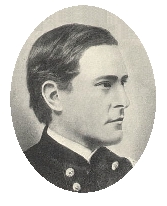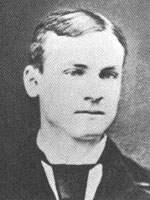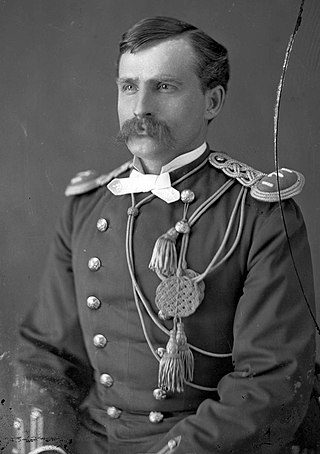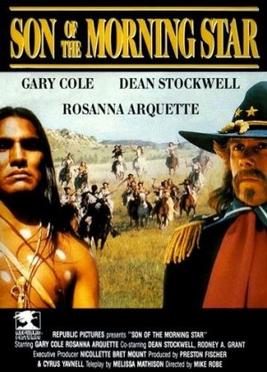
The Battle of the Little Bighorn, known to the Lakota and other Plains Indians as the Battle of the Greasy Grass, and commonly referred to as Custer's Last Stand, was an armed engagement between combined forces of the Lakota Sioux, Northern Cheyenne, and Arapaho tribes and the 7th Cavalry Regiment of the United States Army. The battle, which resulted in the defeat of U.S. forces, was the most significant action of the Great Sioux War of 1876. It took place on June 25–26, 1876, along the Little Bighorn River in the Crow Indian Reservation in southeastern Montana Territory.

George Armstrong Custer was a United States Army officer and cavalry commander in the American Civil War and the American Indian Wars.

Crazy Horse was a Lakota war leader of the Oglala band in the 19th century. He took up arms against the United States federal government to fight against encroachment by white American settlers on Native American territory and to preserve the traditional way of life of the Lakota people. His participation in several famous battles of the Black Hills War on the northern Great Plains, among them the Fetterman Fight in 1866, in which he acted as a decoy, and the Battle of the Little Bighorn in 1876, in which he led a war party to victory, earned him great respect from both his enemies and his own people.
Evan Shelby Connell Jr. was a U.S. novelist, short-story writer, essayist and author of epic historical works. He also published under the name Evan S. Connell Jr.

Little Bighorn Battlefield National Monument preserves the site of the June 25 and 26, 1876, Battle of the Little Bighorn, near Crow Agency, Montana, in the United States. It also serves as a memorial to those who fought in the battle: George Armstrong Custer's 7th Cavalry and a combined Lakota-Northern Cheyenne and Arapaho force. Custer National Cemetery, on the battlefield, is part of the national monument. The site of a related military action led by Marcus Reno and Frederick Benteen is also part of the national monument, but is about 3 miles (4.83 km) southeast of the Little Bighorn battlefield.

Marcus Albert Reno was a United States career military officer who served in the American Civil War where he was a combatant in a number of major battles, and later under George Armstrong Custer in the Great Sioux War against the Lakota (Sioux) and Northern Cheyenne. Reno is most noted for his prominent role in the Battle of the Little Bighorn, where he did not support Custer's position on the battlefield, remaining instead in a defensive formation with his troops about 4 miles (6.4 km) away. This event has since been a longstanding subject of controversy regarding his command decisions in the course of one of the most infamous defeats in the history of the United States military.

Frederick William Benteen was a military officer who first fought during the American Civil War. He was appointed to commanding ranks during the Indian Campaigns and Great Sioux War against the Lakota and Northern Cheyenne. Benteen is best known for being in command of a battalion of the 7th U. S. Cavalry at the Battle of the Little Bighorn in late June, 1876.

Goes Ahead was a Crow scout for George Armstrong Custer’s 7th Cavalry during the 1876 campaign against the Sioux and Northern Cheyenne. He was a survivor of the Battle of the Little Big Horn, and his accounts of the battle are valued by modern historians.

Henry Armstrong Reed was the nephew of George Armstrong Custer, Thomas Custer, and Boston Custer. Although not an official soldier, he was killed along with them at the Battle of the Little Bighorn at the age of 18.

William Winer Cooke was a military officer in the United States Army during the American Civil War and the Black Hills War. He was the adjutant for George Armstrong Custer and was killed during the Battle of the Little Bighorn.

"Lonesome" Charley Reynolds was a scout in the U.S. 7th Cavalry Regiment who was killed at the Battle of the Little Bighorn in the Montana Territory. He was noted as an expert marksman, frontiersman and hunter. He had also been a scout with Buffalo Bill.

Algernon Emory Smith was an officer in the U.S. 7th Cavalry Regiment who was killed in the Battle of the Little Bighorn in the Montana Territory.

Bloody Knife was an American Indian who served as a scout and guide for the U.S. 7th Cavalry Regiment. He was the favorite scout of Lieutenant Colonel George Armstrong Custer and has been called "perhaps the most famous Native American scout to serve the U.S. Army."
Wooden Leg was a Northern Cheyenne warrior who fought against Custer at the Battle of the Little Big Horn.

They Died with Their Boots On is a 1941 American Biographical western film from Warner Bros. Pictures, produced by Hal B. Wallis and Robert Fellows, directed by Raoul Walsh, that stars Errol Flynn and Olivia de Havilland.
Isaiah Dorman was an interpreter for the United States Army during the Indian Wars. He perished at the Battle of Little Bighorn, the only black man killed in the fight.

Comanche was a mixed-breed horse who survived George Armstrong Custer's detachment of the United States 7th Cavalry at the Battle of the Little Bighorn.

Captain Thomas Benton Weir was an officer in the 7th Cavalry Regiment, notable for his participation in the Battle of the Little Bighorn, also known as Custer's Last Stand.

Son of the Morning Star is a 1991 American two-part Western television miniseries released by Chrysalis based on Evan S. Connell's best-selling 1984 book of the same name. It starred Gary Cole and featured Dean Stockwell, Rosanna Arquette, Rodney A. Grant, Nick Ramus, Buffy Sainte-Marie, and Floyd Red Crow Westerman.

Killing Crazy Horse: The Merciless Indian Wars in America is a book written by Bill O'Reilly and Martin Dugard about clashes with Native Americans during the American Indian Wars of the 1800s. It is the ninth book in the Killing series, following Killing Lincoln, Killing Kennedy, Killing Jesus, Killing Patton, Killing Reagan, Killing the Rising Sun, Killing England and Killing the SS. The book was released on September 8, 2020.
















